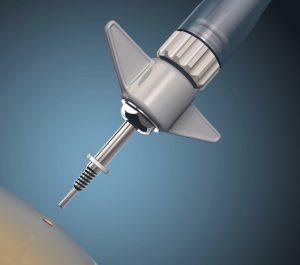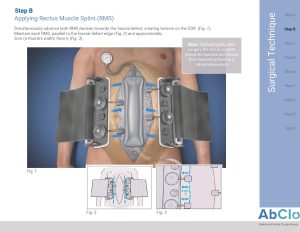
When training a surgical team or rolling out a new medical device, any misstep can cost time, money – and even patient safety. Medical illustrations and medical animations aren’t just pretty pictures. These visuals act as unambiguous guides through each procedure and device interaction. When incorporated into Instructions for Use (IFU) or a Surgical Training Manual (STM), these communication tools translate dense technical content into intuitive visual stories that are readily understood and remembered.
Combining step-by-step artwork, ranging from 2D illustrations to advanced dynamic motion 3D medical animations, with explanatory text, can reduce errors, accelerate onboarding and improve retention.
The Science Behind Seeing: Why images outperform words
Picture this: A 20-page IFU is filled with sentences like “…perform the proximal tibial cut by aligning the cutting block in the sagittal and coronal plane, rotating it to a 45° angle, then retracting it by 2cm utilizing the alignment handle…” Imagine instead, a three-panel medical illustration showing exactly these actions. Which would be more reliable under pressure?
1. Speed of comprehension
- A single image can often replace a paragraph of text. Visuals let the medical team scan, absorb and act – in seconds.
2. Reduced ambiguity
- Text can be vague — terms like “juxtapose” or “align” leave room for interpretation, and hence confusion. Visuals, on the other hand, provide a precise and consistent understanding for everyone (see Figure 1).
3. Improved retention
- Cognitive research shows that visual information sticks. Medical personnel will recall an illustrated sequence far more reliably than a text description.
In short, medical illustrations become the “universal language” of IFUs and STMs, with no ‘translation’ required.
Figure 1: Medical illustrations and animations reduce ambiguity and provide a precise and consistent understanding when used in an IFU or STM.
From Static to Step-by-Step: The power of sequential illustrations
When a complex procedure is broken into numbered image frames, it facilitates:
-
Time to pause & review
Surgeons can stop on ‘frame 3’ to double-check a critical step.
-
On-the-fly reference
Nurses can flip to the exact step they need without wading through paragraphs of copy.
-
Consistency across teams
Every reader sees the same diagram, eliminating the ‘guessing game’ of interpretation.
For instance, in an IFU for a new arterial catheter-insertion kit, an illustration series showing the assembly of each component and insertion protocol could cut setup time in half. That’s the difference between struggling in the OR and performing with efficiency.
Animations in Action: Bringing procedures to life
Static illustrations are effective, but sometimes movement is required to truly understand how components interact. That’s where medical animations excel:
-
Sequential storytelling
Watching a laparoscopic artificial graft placement or a spring-loaded valve clicking into place, is far more intuitive than picturing it in the mind’s eye.
-
Interactive playback
Learners can pause, rewind, or slow down a clip, revisiting any moment until it is fully understood.
-
Catering to different learning styles
While some team members thrive on diagrams with text, others learn best by seeing things in motion. Detailed medical animations ensure no one is left behind.
Gaining Perspective: Adding depth with 3D medical animations
Sometimes, 2D portrayals can’t capture spatial relationships – such as the pathway of a stent inserted into the fine vasculature of the brain for arteriovenous malformation treatment. 3D medical animation services go well beyond flat diagrams, with the inclusion of:
1. Camera zooms & pivots
Highlighting intricate fine features by zooming into key anatomical elements.
2. Cut-away & transparent views
These reveal anatomical details or internal device mechanics such as connections, bearings, and fluid channels, without losing context.
3. Dynamic lighting & shading
Digital techniques are used to accentuate structures, textures and material differences, to improve depth perception (see Figure 2).
By layering realistic portrayal of structures and devices with physics-based motion, 3D medical animation bridges the gap between schematic and surgical reality. Showing exactly how a device sits in three dimensions helps build a mental map that translates directly to the operating room.

Figure 2: Digital techniques such as dynamic lighting are used to accentuate structures, textures and material differences, optimizing depth perception and context.
Showcasing Mechanisms: Medical device animations
The unique features of a device deserve to be in the spotlight. Medical device animation allows for:
- Illustrating internal workings like fluids dynamics, gear integration, and mode of action.
- Contrasting “normal operation” with “failure modes” to underscore safety protocols.
- Demonstrating maintenance steps, such as filter or battery changes, in a clear, easy-to-follow clip.
For example, a concise 45-second animation of an infusion pump’s alarm reset sequence can eliminate setup errors and streamline training. It’s the digital equivalent of having an expert tutor at every workstation.
Merging Static & Dynamic: The rise of animated manuals
Animated manuals – including surgical training manuals, integrate still art and motion clips into a seamless learning experience:
-
Hybrid PDFs & e-Learning
Animations can be embedded directly into interactive PDFs or SCORM-compliant e-learning modules.
-
On-Demand Streaming
Videos can be hosted on Learning Management System (LMS) platforms, accessible via desktop, tablet, or mobile – ideal for point-of-care reference.
-
Branching Scenarios
Decision-tree animations allow users to choose a path and see the consequences of different actions.
This hybrid approach ensures that every user, from field technicians to seasoned surgeons, has access to the right medium at each moment – still frames for quick reference and animations for motion clarity.
Beyond Print: Digital & interactive enhancements
In today’s connected world, digital engagement is essential, including:
-
Augmented Reality (AR) Overlays
Using a tablet or AR headset, trainees can overlay 3D models onto real equipment, comparing their setup to the ideal.
-
Virtual Reality (VR) Simulations
Device implantation can be practiced in a risk-free, fully immersive environment before ever setting foot in the OR.
-
Interactive Hotspots
Clickable call-outs in animations allow users to dive deeper into component specs or view safety checklists on demand.
By harnessing these tools, passive users are transformed into active participants, taking engagement and retention to new levels.
Regulatory Confidence: Meeting FDA & ISO standards
In regulated industries, training documentation isn’t just instructional, it’s also a part of a complete compliance process. Artery Studios helps by:
- Aligning instructional visuals with FDA guidance on IFU clarity and readability.
- Ensuring consistency with ISO 13485 documentation requirements.
- Providing high-resolution assets that pass audit scrutiny.
Our medical illustrations and medical animations don’t just look good; they’re crafted with the precision and accountability auditors demand, reducing concerns when filing submissions.
Working Together: Our collaborative process
Engaging Artery Studios means tapping into a proven workflow honed over three decades:
Project kickoff
A discovery meeting gets everyone on the same page for a full understanding of the biomedical and technical issues that need to be portrayed – innovative features, clinical advantages, audience, etc.
Proposal
After careful review of the key information and goals, a detailed proposal is crafted by Artery Studios, describing in detail the biomedical and technical visuals that can be created.
Drafts & Storyboarding
Rough sketches for illustration projects and storyboards for animations are developed, ensuring all visual content is clear and accurate.
Illustration & animation production
The certified medical illustrators and animators at Artery Studios craft each image and frame with pixel-perfect detail, whether static illustrations or fully rendered 2D and 3D animations.
Review & revision
After, gathering feedback, and revisions are incorporated.
Final delivery
Publication and print-ready images as well as video files are delivered via a secure link, to integrate seamlessly into Instructions for Use, Surgical Training Manuals or Learning Management Systems.
This structured approach not only accelerates timelines but also safeguards quality, for timely deployment of communication initiatives.
Conclusion: Clarity saves lives
In the world of medical innovation, ambiguity is the enemy. Whether drafting an IFU for a cutting-edge implant or building a surgical training curriculum, medical illustrations and medical animations from Artery Studios put clarity front and center. Our combination of detailed images, dynamic motion, and emerging interactive technologies, backed by 30 years of experience as North America’s premier medical visualization provider, means the biomedical visuals we craft are flawless and readily integrated into educational and training projects.
Ready to transform your documentation into crystal-clear, action-ready visual guides? Contact Artery Studios today – let’s craft a visual strategy that accelerates learning, reduces errors, and ultimately saves lives.

